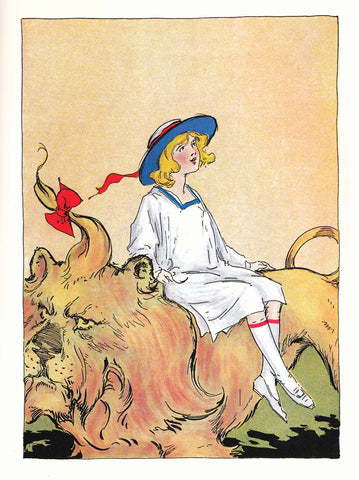 VISIT
MUSEUM STORE
MEMBERSHIP
OZ NEWS
CONTACT
VISIT
MUSEUM STORE
MEMBERSHIP
OZ NEWS
CONTACT
IS THERE ANY REAL, RESOUNDING REASON FOR RUBY-RED RUTABAGA? -- PART THREE
Wamego#42
April 3, 2015 IS THERE ANY REAL, RESOUNDING REASON FOR RUBY-RED RUTABAGA? -- PART THREE



[At left above: The TV GUIDE/General Electric Company ad for NBC’s cartoon special, RETURN TO OZ, first telecast on February 9, 1964. Center: A TV GUIDE “Close-Up” summary, describing the program when it was to be rerun by the network on February 21, 1965. Right: The shell-case cover for one of the DVD releases of RETURN TO OZ. The fifty-one minute film was produced by Videocraft International, Ltd., as a semi-lavish extension of the characters and concepts they’d devised four years earlier for TALES OF THE WIZARD OF OZ, a series of five-minute animated shorts. Details about that preliminary Rankin/Bass endeavor were featured here in Part One and Part Two of the “…Ruby-Red Rutabaga” blogs for March 20th and 27th.]
--------------------------
Beginning in autumn 1961 – and thanks to a reasonable amount of syndication throughout local television markets -- the TALES OF THE WIZARD OF OZ cartoons enjoyed a measure of familiarity with predominantly young audiences for several seasons. One can’t say these early efforts from Arthur Rankin, Jr. and Jules Bass were overwhelmingly popular; even given the questionable merits of the product, the OZ episodes never benefitted from the exposure that might have accrued from a regular network time slot (whether amongst the standard Saturday morning programming-for-kids or the type of evening showcase then afforded such contemporary animations as those of THE BULLWINKLE SHOW or THE FLINTSTONES). Yet the Rankin/Bass OZ designs manifested enough push-and-response to eventually attain two hallmarks of that era’s entertainment capitalization: a wave of merchandising and their own TV “special.”
The preceding two weeks of this blog were topped off by illustrations from the commercial TALES OF THE WIZARD OF OZ comic and coloring books, published in 1962. Also available circa 1962-63 – if not always in major distribution – were a “magic” slate, a coin purse, Halloween costumes, and dolls.
But the real (if ultimately fleeting) indication that the Videocraft International, Ltd., series -- somewhere and somehow -- had impressed someone came when their RETURN TO OZ, an hour-long “sequel” to THE WIZARD OF OZ, was shown coast-to-coast by NBC late in the afternoon of February 9, 1964. Sponsored by General Electric and with a script by Romeo Muller, the much-heralded “family event” was a bit more carefully drawn and detailed than the earlier, five-minute R/B episodes. A further plus came when most of the original voice actors from TALES OF THE WIZARD OF OZ were re-engaged for the RETURN, thus fulfilling any expectations of their fans. These cast members included Larry Mann (Rusty Tin Man), Alfie Scopp (Socrates Strawman), Carl Banis (The Wizard; he also replaced Paul Kligman as Dandy Lion), Pegi Loder (The Wicked Witch of the West and Glinda), and the once-again uncredited Stan Francis (Toto). A talent search was conducted for a young girl to sing the role of Dorothy; another young actress delivered that character’s lines, and both of these twelve-year-old performers were new to the R/B Oz repertory. Susan Conway -- the “acting” Dorothy – did a commendable job, if frequently saddled with somebody’s notion of Midwestern speak (“Glinda, ma’am! Glad ta see ya!.... I’m so glad you showed up!”). Susan Morse sang very well, indeed, and occasionally sounded like a young Liza Minnelli, had the latter ever possessed a genuinely good voice. Per the girl’s recollections, Morse’s vocals were recorded in New York City; the other tracks were laid down in Toronto at the RCA Studios.
To further up the ante – and to compete with the tuneful, then-annual CBS network telecast of the 1939 Metro-Goldwyn-Mayer THE WIZARD OF OZ -- Gene Forrell, Edward Thomas, and James Polack (with additional music by George Wilkins) provided RETURN TO OZ with the melodies and lyrics for no less than ten songs. Though far from the sophisticated musical comedy material done by Harold Arlen and E. Y. “Yip” Harburg for Metro, the cartoon’s numbers were uniformly pleasant or jaunty, successfully written for child appeal and accessibility: “I Wanna Go Back” (aka “Oz Just Can’t Continue Without Me,” sung by Dorothy and later reprised as “Kansas Can’t Continue Without Me”), “Everywhere in Oz” (choral group, accompanying the opening and closing credits of the program), “We’re Munchkins, Naturally” (Dorothy and The Munchkins), “I’m the Wickedest, Wicked Old Witch There Is” (The Wicked Witch of the West), “I’m Heartless Through and Through” (Rusty), “You Can’t Buy a Brain” (Socrates, Dorothy, and Rusty), “He’s a Dan-Dan-Dandy Lion” (Rusty and Socrates), “I Am, I Am, I Am Better Than You Are” (The Wicked Witch and The Wizard), and “Here Comes a Moonbeam” (Dorothy). A demonstration record of the score posts one extra routine, “I’m A Wise Old Wiz of a Wizard” to be sung by Oz himself, but his rendition never made it into the completed show. (A contemporary newspaper clipping suggests that RETURN TO OZ initially was conceived to fill a ninety-minutes-with-commercials running time, but no other source confirms this.)
[As an historical note, the principal creative participants in RETURN TO OZ also included producer Arthur J. Rankin, Jr., co-producer Jules Bass, directors F. R. Crawley, Thomas Glynn, and Larry Roemer, and more than twenty animators, their assistants, and “background”-ers. The drawings were done at Canada’s Crawley Films studio; press hype in 1964 claimed a staff of “forty” had been responsible for 140,000 OZ drawings.]
----------------
After two-and-a-half-years of the sometimes-mindless (and sometimes only semi-Ozzy) TALES OF THE WIZARD OF OZ cartoons, my 1964 anticipation for the RETURN TO OZ special was definitely tempered. But I certainly looked forward to all the attendant hoopla, hoped for the best, and as a result, was – at my purist-worst – only minimally rewarded/disappointed. Revisiting at the program again, as I did earlier this week, I now can see that the wonders it purveyed were geared toward a solidly juvenile audience; at thirteen, I wasn’t exactly Noel Coward, yet even at that age, I someway expected and wanted more for the general Oz franchise!
Granted, there were certain scripting touches that would have piqued the sense of humor of any parents or adults who rode out the hour five decades ago:
- As Socrates reflected on the ultimate ineffectuality of the brain presented him by The Wizard, he decided, “My thinker was a clinker.”
- When the Giant Head of the Great Oz (briefly under the jurisdiction of The Wicked Witch) demanded Dorothy’s silver slippers in return for the girl’s requests, Socrates wondered, “What's he want shoes for, anyway? He doesn't have any feet!” In turn, Dandy made a counteroffer: “How'd you'd like a nice pair of earmuffs, instead?”
- Dorothy’s friends tried to convince her to trade her slippers for the replacement brains, heart, and courage offered by the Giant Head by declaiming “I’ll get you new shoes!” “I’ll even get you SKIS!”
- When the travelers commented that the voice emanating from Oz’s gigantic noodle sounded different, The Witch behind-the-curtain mentioned suffering a cold, to which Dandy opined, “It must be a head cold.”
- In an attempt to ensnare and capture The Wizard, The Wicked Witch of the West transformed herself into a curvaceous blonde: an amalgam of Greta Garbo and Natasha Fatale of BULLWINKLE fame (with a soupçon of Eva Gabor/GREEN ACRES foreshadowing). The music track moaned a sultry saxophone underscoring as she sauntered into view, and Oz -- who’d been expecting a nuisance caller – exclaimed “They don't make busybodies like that anymore!” He went on to reference her as "My little drop of Munchkin dew.”
- The Wicked Witch controlled three Winged Monkeys, whose wings were on their feet (a la random conceptions of the Mercury of Roman mythology). In the Rankin/Bass retelling, they were more like The Three Stooges in their hopeless bungling; when they failed to take flight to seize Dorothy & Company, the Witch complained “You couldn’t catch a cold.” She elsewhere labeled them “Nincompoop-a-doopies!”
There were other comedic and/or inventive bits. The Witch had forsaken her broom and instead flew on a magic umbrella. She descended to the cellar of her fortress (much like the Evil Queen did in Walt Disney’s SNOW WHITE AND THE SEVEN DWARFS) to commandeer the services of flying alligators, intending that they waylay and kill Dorothy, et al. In Rankin/Bass Land, the Munchkins grow on trees, albeit still jabbering as nonsensically as they did in the TALES OF THE WIZARD OF OZ cartoons. There was a cameo appearance by The Wretched Witch of the Wastelands, from whom The Wicked Witch borrowed a cache of temporary magic so as to administer her bid for conquest. (It seems the puddle that remained after Dorothy melted her somehow “froze up” once the Ozian winter arrived, and the WWW grew into her previous heinous form and fortitude.)
The show’s vocal interpretations basically echoed those of the earlier TALES, with The Witch handily channeling Jonathan Winters’ Maude Frickert impression. The Wizard, however, seemed much less W. C. Fields than before, and his character displayed an annoying habit of repeating the final words of his sentences. (It’s an even bet that the scenarist probably felt this would be amusing or endearing.) The new voice for Dandy was much more Joe Besser than Bert Lahr, and Glinda –as a fresh participant in the R/B pantheon – offered an unambiguous and tinkling Billie Burke imitation, up to and encompassing a few “mid-Atlantic” rolled r’s.
Still, the overall plot line essentially and merely rehashed L. Frank Baum’s original story – with legally-boundaried nods-in-passing to the MGM film. In brief: Dorothy receives a letter from Socrates, inviting her to RETURN TO OZ. What the girl doesn’t know is that the missive in reality was composed by the resuscitated Wicked Witch, who wants another crack at accessing Dot’s silver slippers. To effect Dorothy’s visit – and to quote the legendary Martin Gardner (who reviewed RETURN TO OZ for The International Wizard of Oz Club magazine in 1964) – “The writer thought of a clever way: a cyclone!” Back in Munchkinland, Dorothy is greeted by Glinda, who explains the Witch’s ruse and shares the fact that the harridan also has managed to jettison the brains, heart, and courage achieved by Dorothy’s comrades. So the famous five (Toto made the journey from Kansas as well) go off to see the Wizard. All of them – including Oz – end up in the Witch’s Castle before a denouement in which the villainess is turned to stone by the silver slippers. Reunited in the Emerald City, Glinda points out that Dorothy’s associates once again proved that they already possessed the qualities they sought: Socrates when he came up with a plan to save the gang from the alligators; Rusty when he demonstrated his love for his friends by taking a lightning bolt meant to kill them all; and Dandy when he dared to handle the silver slippers, even though he knew they would turn any coward to stone. The Good Witch next directs Dorothy to petition for “Kansas magic” to restore her to Aunt Em and Uncle Henry, and a second, most obliging cyclone turns up to provide transport.
Although its dependence on the first OZ book more-or-less eliminated any overwhelming ingenuity in the RETURN TO OZ scenario, the show managed to incorporate a couple of Baum-centric virtues and philosophies. As noted, Dorothy’s colleagues manifested their supposedly missing components at several salient moments. The girl selflessly asked The Great Oz for the boons craved by Socrates, Rusty, and Dandy, while never broaching her own desire. Much as The Scarecrow in THE WIZARD OF OZ book allowed his straw to be removed and used as a protective cover for Dorothy, Toto, and The Cowardly Lion against The Wicked Witch’s swarm of bees, Socrates encouraged the same action so as to hide his companions from the flying alligators. And Glinda delivered a final, fitting, and quietly stirring paean to compassion by drawing some specific parallels: "The [Wicked] Witch was heartless, as anyone is who is cruel; cowardly, as anyone is who must use slaves and suppress others; and brainless, as anyone is who thinks evil can conquer good."
--------------
So…what? A mixed bag? Maybe it’s most personally accurate for me to acknowledge that RETURN TO OZ wasn’t all that this “lover of Oz” might have wished…but it certainly did no long (or even short) term harm to the greater legend or legacy. Now, in retrospect, it seems to have earned its own low-key fascination and worth as one of the almost countless Oz interpretations across pop culture history.
For all of that, it’s also a colorful, musical, nicely simple off-shoot!
And if any of these three Rankin/Bass “recountings” since March 20th encourage you to seek out the Videocraft Oz-related product, I’d venture the following theory: “That old Oz magic has you in its spell….”
(So, thank you and good-night, Johnny Mercer!)
P.S. Singular appreciation to long-time Oz Club compatriot Eric Gjovaag, who – a number of years ago – recorded RETURN TO OZ and a raft of the TALES OF THE WIZARD OF OZ cartoons off local television, transferred ‘em to disc, and generously shared the lot! Without his thoughtful kindness, my reportage would have been much less-informed. (Of course, it then would have been much shorter…so this might be a propitious moment for Eric to hide from any bleary-eyed and revengeful Fricke readers!)
Seriously: My sincere thanks to you, sir.
P.P.S. And yes, I DO know that Sunday, February 9, 1964, also marked another extraordinary pop culture television event. At 9 p.m. EST, CBS presented that week’s episode of THE JUDY GARLAND SHOW – and it was the first of her series that she performed as a one-woman show! Don’t think THAT didn’t have my complete, undivided, and awestruck attention.
P.P.P.S. Look…. After all my formative years spent in the company of Garland, MGM, Broadway original cast albums, motion picture soundtrack recordings, and the great popular songbook and its supreme interpreters, four guys from England on THE ED SULLIVAN SHOW – with their three guitars and drum set (as compared to a thirty-two piece Mort Lindsey Orchestra ) -- were just NEVER gonna cut it.
P.P.P.P.S Thanks for reading!
Article by John Fricke



